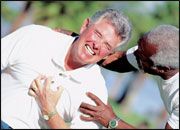Publication
Article
Pharmacy Times
Roundup: Reviewing the Pharmacotherapy of AMI in the Health System
Mortality rates for acute myocardial infarction have decreased, but rapid response and chronic management are key to improving outcomes.
Ms. Dang, Mr. Chang, Ms. Mai, andMs. Xie are PharmD candidates fromWestern University of Health Sciences,College of Pharmacy, in Pomona,California. Dr. Pham is assistant professorof pharmacy practice at WesternUniversity of Health Sciences, College ofPharmacy.

Approximately 1.5 million peoplein the United States experienceacute myocardial infarction(AMI) each year—nearly one thirdresult in mortality, and almost half ofthose mortalities occur before patientsreceive medical treatment.1 Most AMIpatients present with thrombotic occlusionof the coronary artery, whichoccurs when atherosclerotic plaquessuddenly rupture, resulting in partial ortotal occlusion of the coronary artery.The AMI mortality rate has decreasedover the past decade due to better controlof risk factors for coronary arterydisease, such as control of hypertension,diabetes, and hyperlipidemia, combinedwith increased use of aspirin, heparin,thrombolytic therapy, and coronaryangioplasty.1
AMI diagnosis requires at minimum2 of the following 3 criteria: (1) clinicalhistory of ischemic-type chest discomfort;(2) serial electrocardiographictracings indicative of AMI; (3) a rise andfall in serum cardiac markers. If chestpain presents together with ST segmentelevation, the likelihood that the patienthas an AMI is greater than 90%.2
Heaviness, pressure, squeezing, ortightness in the chest, persisting 30 minutesor longer and radiating to the arms,neck, or jaw, often describe an AMI.Many patients also present with dyspnea,diaphoresis, nausea, and emesis;however, about one fourth experiencemild to no symptoms.1
The rate of morbidity and mortalityis decreased when pharmacotherapy isaimed at restoring coronary blood flowin the occluded artery in a time-specificmanner. The administration of oxygenvia nasal prongs, intravenous (IV) analgesiawith morphine sulfate, oral aspirin,and sublingual nitroglycerin should beadministered early to achieve hemodynamicstability. Aspirin should be maintainedindefinitely, as it is associatedwith a 25% reduction in death, nonfatalreinfarction, and stroke.3
Reperfusion through thrombolysis orpercutaneous coronary angioplasty is astandard treatment in impending AMI.Early reperfusion can reduce myocardialdamage and preserve left ventricularfunction, leading to decreased mortality.Thrombolytic agents available includeserine proteases that convert plasminogento plasmin, which breaks downfibrinogen and fibrin contained in a clot.
Streptokinase is the least expensivefibrinolytic agent, but it is highly antigenicwith unfavorable adverse reactionsresulting in limited clinical use.Urokinase-like plasminogen activatorsare produced in renal cells, circulate inthe blood, and are excreted in the urine.Their ability to catalyze the conversionof plasminogen to plasmin is affectedonly slightly by the presence or absenceof local fibrin clot.
Alteplase (tPA, Activase) was thefirst recombinant tissue-type plasminogenactivator (tPA) most often used totreat coronary artery thrombosis, pulmonaryembolism, and acute ischemicstroke. Reteplase (r-PA, Retavase) isa second-generation recombinant tPAwith fast onset, low bleeding risk, andlow antigenic property, compared withalteplase. Tenectaplase (TNKase), pharmacologicallysimilar to alteplase, wasapproved by the FDA as a fibrinolyticagent and is the latest thrombolyticagent approved for managing AMI.
The major complication of fibrinolysisis intracranial hemorrhage, butserious hemorrhagic complications canoccur from bleeding at any site in thebody. Common hemorrhagic problemsseen after thrombolytic therapy includereperfusion arrhythmia, hypertension,gastrointestinal bleeding, retroperitonealbleeding, pericardial bleeding,genitourinary bleeding, epistaxis, ecchymosis,gingival bleeding, and bleedingfrom puncture sites. Large hematomasat peripheral arterial puncture sitesoccasionally can cause a compartmentsyndrome. Risk factors for hemorrhagiccomplications include increasing age,elevated pulse pressure, uncontrolledhypertension, recent stroke, recent injuryand recent surgery, the presence of ableeding diathesis, severe chronic heartfailure, and recent vascular puncture.
The use of percutaneous coronaryintervention (PCI) to abort a myocardialinfarction (MI) is known as primaryPCI. Primary PCI is superior to fibrinolytictherapy when performed rapidlyby expert teams. The goal of primaryPCI is to open the artery, preferablywithin 90 minutes upon the patient'sarrival at the emergency department,also referred to as the "door-to-balloon"time. Primary PCI is often performedwith a coronary angiogram to determinethe location of the infarcted vessel,followed by balloon angioplasty atthe thrombosed arterial segment. Anextraction catheter may be used in anattempt to aspirate the thrombus priorto balloon angioplasty. More frequently,an intracoronary stent is deployed todecrease the rate of restenosis, althoughstent placement does not improve theshort-term outcomes of primary PCI,compared with balloon angioplasty.
Adjuvant therapy during primary PCIincludes IV heparin, oral aspirin, andoral clopidogrel. The glycoprotein IIb/IIIa inhibitors are often used in primaryPCI to reduce the risk of ischemic complications.Due to the number of antiplateletagents and anticoagulants usedduring primary PCI, the risk of bleedingassociated with the procedure is high.Anticoagulants such as heparins, fondaparinux,or direct antithrombin inhibitorsare indicated for acute coronarysyndrome (ACS) patients undergoingreperfusion therapy due to reduction ofmortality, reinfarction rates, and recurrentischemic events.4
Heparin, an indirect thrombin inhibitor,interacts with antithrombin to rapidlyinactivate thrombin (factor Xa)along with factors XIIa, XIa, and IXa. Inpatients with non?ST-segment elevationmyocardial infarction (NSTEMI) whowere given aspirin, unfractionated heparin(UFH), and low-molecular-weightheparin (LMWH) have been shownto decrease the risk of MI or deathby 50%.5 Enoxaparin, an LMWH, hasdemonstrated comparable or superiorbenefit to UFH in reducing death andcardiac ischemic episodes in NSTEMIpatients and possesses several advantagesover UFH, such as a more predictableanticoagulant effect requiring lessmonitoring, easy administration, andlowered risk of heparin-induced thrombocytopenia(HIT).6,7 Furthermore, ameta-analysis of trials that comparedUFH and enoxaparin in ST-segment elevationmyocardial infarction (STEMI)patients receiving fibrinolysis suggestedthat enoxaparin significantly reduceddeath and MI, compared with UFH at30 days, which compensated for theincreased incidence of major bleed.8Thus, enoxaparin has an indication forthe management of patients with acuteSTEMI undergoing reperfusion therapy.
Fondaparinux, a synthetic heparinpentasaccharide, is preferred in NSTEMIpatients with increased risk of bleedingand also recommended in favor of UFHin patients with NSTEMI undergoingconservative procedures unless a coronaryartery bypass graft is planned within24 hours.4 Unlike heparin-antithrombincomplexes, which cannot bind orinactivate thrombin inside a clot, directthrombin inhibitors are another classused in ACS that can inactivate thrombinin blood clots. Bivalirudin is recommendedin patients with NSTEMIundergoing invasive therapy and canalso be used as an alternative for STEMIpatients receiving fibrinolytics whodevelop HIT from UFH.9 Evidence supportsthe use of anticoagulants in ACS,but the choice of anticoagulant dependson overall treatment regimen and shouldbe patient-specific.
Along with reperfusion therapy, theAmerican College of Cardiology/AmericanHeart Association (ACC/AHA) recommendsacute management of ACSpatients with medications such asaspirin, nitrates, morphine sulfate, andbeta-blockers. Oxygen also should beadministered to all patients presentingwith ischemic-type chest discomfort tolimit myocardial injury and decrease theamount of ST-segment elevation. Aspirinis the initial line of drug therapy forpatients with suspected ACS—the recommendeddose is 162 to 325 mg chewedto allow rapid buccal absorption.9 Aspirinwill have an immediate antithromboticeffect by irreversibly binding to cyclooxygenaseand inhibiting thromboxaneA2 production. Evidence suggests thatchronic aspirin use significantly decreasesmortality, nonfatal reinfarction, andstroke in ACS patients.10
Nitroglycerin produces venous andmodest arterial dilation to decreasepreload and some afterload, ultimatelyallowing increased perfusion of blood toischemic zones, and reduces myocardialoxygen demand.11 Although no mortalitybenefit exists, nitroglycerin is effectivein relieving chest pain.12
Morphine sulfate also alleviates chestpain through its analgesic properties,lowering circulating catecholamines, decreasingmyocardial oxygen consumption,and decreasing preload throughvenodilation and arterial vasodilation. Italso lowers the heart rate by increasingvagal tone and thus decreases the cardiacworkload.9,13
A cardioselective beta-blocker is crucialfor the management of ACS, becauseit reduces heart rate, blood pressure,and contractility, which in turndecreases oxygen demand and relievesischemic chest pain. IV administrationsof cardioselective beta-blockers such asatenolol and metoprolol have been wellstudied and shown to reduce morbidityand mortality.14
Chronic management is indicated forACS patients with comorbidities such as,but not limited to, hypertension, diabetes,and hyperlipidemia. The ACC/AHAguidelines recommend starting an oralangiotensin-converting enzyme (ACE)inhibitor/angiotensin receptor blockerwithin the first 24 hours in stable STEMIpatients, but not IV ACE inhibitors inpatients categorized as class III due to thepossibility of hypotension.9 ACE inhibitorsact as vasodilators to reduce preloadand afterload and inhibit activation ofaldosterone to reduce volume retentionand to prevent cardiac remodeling. TheGISSI-3 and ISIS-4 studies have shownreduction in morbidity and mortality withACE inhibitors.15 The ACC/AHA also recommendsassessing the patient's fastinglipid profile within 24 hours of an ACSevent and initiating chronic statin therapyto lower the low-density lipoprotein levelto <100 mg/dL in an attempt to preventanother ACS episode.9
Patients presenting with ACS shouldbe stabilized through acute managementand, to prevent another ACS event,chronic pharmacologic management.Patients with persistent ACS symptoms,despite taking the first dose of sublingualnitroglycerin, should be transportedby ambulance to the emergency department.Upon confirmation of STEMIwith onset of symptoms less than 12hours, patients should receive immediatereperfusion therapy with either PCIor fibrinolytics to restore blood flow.Anticoagulation and antiplatelet therapyshould be administered before reperfusiontherapy. Aspirin, nitrates, morphinesulfate, cardioselective beta-blockers,and oxygen are also indicated for acutemanagement, unless contraindicated.9Chronic management should be initiatedonce the patient's condition is stable, andtherapy should be based on coexistingmedical conditions.
Formulary considerations must take intoaccount all agents used in the managementof AMI. Drug selection should beguided by evidence-based medicine.
References
- Burger PB, Orford JL. VIII Acute myocardial infarction. ACP Medicine Online. June 2006. beta.acpmedicine.com/acpmedicine/institutional/tableOfContent.action#. Accessed November 7, 2008.
- Karlson BW, Herlitz J, Edvardsson N, Emanuelsson H, Sjolin M, Hjalmarson A. Eligibility for intravenous thrombolysis in suspected acute myocardial infarction. Circulation. 1990;82(4):1140-1146.
- Antiplatelet Trialists' Collaboration. Secondary prevention of vascular disease by prolonged antiplatelet treatment. Br Med J. 1988;296(6618):320-331.
- Anderson J, Adams C, Antman E, et al. ACC/AHA 2007 guidelines for the management of patients with unstable angina/non-ST-elevation myocardial infarction: a report of the American College of Cardiology/American Heart Association Task Force on Practice Guidelines. J Am Coll Cardiol. 2007;50(7):e1-e157.
- Eikelboom JW, Anand SS, Malmberg K, Weitz JI, Ginsberg JS, Yusuf S. Unfractionated heparin and low-molecular-weight heparin in acute coronary syndrome without ST elevation: a meta-analysis. Lancet. 2000;355(9219):1936-1942.
- Cohen M, Demers C, Gurfinkel EP, et al. A comparison of low-molecular-weight heparin with unfractionated heparin for unstable coronary artery disease. Efficacy and Safety of Subcutaneous Enoxaparin in Non-Q-Wave Coronary Events Study Group. N Engl J Med. 1997;337(7):447-452.
- Antman EM, McCabe CH, Gurfinkel EP, et al. Enoxaparin prevents death and cardiac ischemic events in unstable angina/non-Q-wave myocardial infarction. Results of the thrombolysis in myocardial infarction (TIMI) 11B trial. Circulation. 1999;100(15):1593-1601.
- Murphy SA, Gibson CM, Morrow DA, et al. Efficacy and safety of the low-molecular weight heparin enoxaparin compared with unfractionated heparin across the acute coronary syndrome spectrum: a meta-analysis. Eur Heart J. 2007;28(17):2077-2086.
- Antman EM, Hand M, Armstrong PW, et al. 2007 focused update of the ACC/AHA 2004 Guidelines for the Management of Patients with ST-Elevation Myocardial Infarction: a report of the American College of Cardiology/American Heart Association Task Force on Practice Guidelines. Circulation. 2008;117(2):296-329.
- Randomised trial of intravenous streptokinase, oral aspirin, both, or neither among 17,187 cases of suspected acute myocardial infarction: ISIS-2. ISIS-2 (Second International Study of Infarct Survival) collaborative group. Lancet. 1988;2(8607):349-360.
- DePace NL, Herling IM, Kotler MN, Hakki AH, Spielman SR, Segal BL. Intravenous nitroglycerin for rest angina. Potential pathophysiologic mechanisms of action. Arch Intern Med. 1982;142(10):1806-1809.
- GISSI-3: effects of lisinopril and transdermal glyceryl trinitrate singly and together on 6-week mortality and ventricular function after acute myocardial infarction. Gruppo Italiano per lo Studio della Sopravvivenza nell'infarto Miocardico. Lancet. 1994;343(8906):1115-1122.
- Braunwald, et al. Management of patients with unstable angina and non-st segment elevation myocardial infarction update. American College of Cardiology Web site. www.acc.org/qualityandscience/clinical/guidelines/unstable/incorporated/III_hospital.htm. Accessed May 21, 2008.
- Teo KK, Yusuf S, Furberg CD. Effects of prophylactic antiarrhythmic drug therapy in acute myocardial infarction. An overview of results from randomized controlled trials. JAMA. 1993;270(13):1589-1595.
- Latini R, Maggioni AP, Flather M, Sleight P, Tognoni G. ACE inhibitor use in myocardial infarction. Summary of evidence from the clinical trials. Circulation. 1995;92(10):3132-3137.
Newsletter
Stay informed on drug updates, treatment guidelines, and pharmacy practice trends—subscribe to Pharmacy Times for weekly clinical insights.







